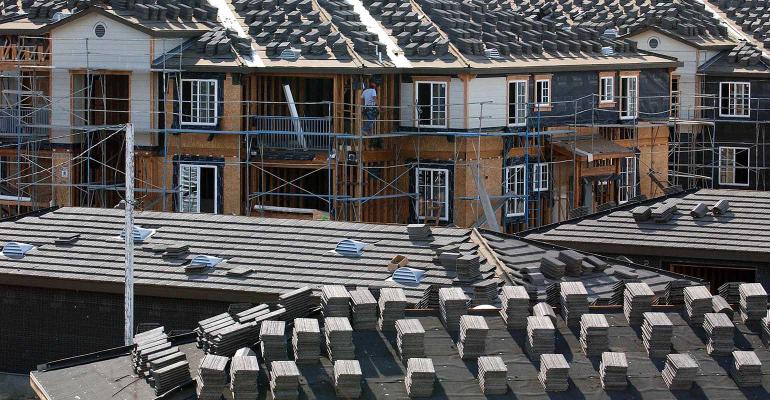When you last visited a supermarket, did you decide between purchasing conventional or organic produce? If so, you probably weighed the pros and cons: typically, regular produce is better for the wallet. Organic is better for the environment.
Similar choices—on a much larger scale—face developers, investors and lenders in the multifamily industry. Simply put, the lower the carbon footprint, the higher the cost to build. That’s why we associate energy efficiency and sustainability with luxury residences. Budget constraints for affordable housing, on the other hand, have limited the prospects for incorporating sustainability into these developments. Until now. Thanks to a combination of incentives, the growing popularity of ESG investing and stricter building codes, affordable housing and decarbonization are no longer mutually exclusive.
Financial incentives
Incentives defray costs for both new construction and retrofits. Fannie Mae and Freddie Mac, for example, have robust programs for green financing. Bob Simpson, founder of Impact Strategies and former affordable housing executive at Fannie Mae, tells me that Fannie is the largest issuer of green bonds in the world. He also notes that Fannie has concluded more than $100 billion in energy-related financing and that Freddie is not far behind.
Rose Companies has taken advantage of Fannie Mae’s green awards program, NYSERDA’s Empire Building Challenge, and several electrification incentive programs offered by the state of California. Rose also pursues Enterprise Green Communities certifications for all new projects and acquisitions and analyzes monthly utility data using Energy ScoreCards. Retrofitting frequently involves upgrades to LED lighting, high-efficiency mechanical equipment, low-flow water fixtures and monitoring of water usage for leaks. Josh Lomot and Michael Brod, project managers with Rose Companies’ environmental impact team, told me that the eventual goal is to power all building mechanical systems with electricity to move their properties closer to net-zero carbon emissions, though a challenge is that at this time, electricity is more expensive than natural gas. Josh and Michael would welcome incentives that would counter these higher costs for owners and residents.
Vesta Corporation is another leader in decarbonization. Joshua Greenblatt, of Vesta, reports that the firm takes steps to address utility and water usage at every opportunity, installs solar panels, upgrades HVAC systems and reduces water usage. Like Rose Companies, Vesta takes advantage of various incentives, one of which is Washington, D.C.’s Solar for All program. Such incentives defray costs for residents and owners alike.
Innovations in the works should make decarbonization initiatives and sustainable building less costly. Ravi Malhotra, founder and president of ICAST, offers the example of heat pumps that provide more efficient cooling, space heating and water heating. These are popular in Europe and Asia, but haven’t yet been adopted widely in the United States.
Although the future looks promising, budgets remain tight today. Alan Mileti, director of maintenance and procurement at Conifer Realty, believes that green energy policymakers don’t always recognize the full extent of the challenges that developers face. He points out that without sufficient incentives, sustainability measures tend to be cut first in the value engineering process.
ESG investing
ESG investing to the rescue! Well, not quite, but it is helping. Bob Simpson has observed a rise in impact investing from private equity outside of the Low-Income Housing Tax Credit (LIHTC) program. And he has come across many investors who ask about the energy efficiency of properties.
Notably, many of the most prominent investors and lenders in the affordable housing space have strict ESG mandates that influence their funding decisions. Citi is aiming for net-zero emissions for its financing by 2050 and for its operation by 2030. Wells Fargo aims to “accelerate the transition to a low-carbon economy.” Bank of America has committed $1 trillion in “low-carbon, sustainable business initiatives through 2030.” JLL takes “urgent climate action that accelerates the transition to net zero, enhances performance, mitigates risks and helps shape a better world.” These are just a few examples. Meanwhile, the popularity of ESG investing continues to grow.
One could argue that by combining affordability and sustainability, lenders and developers are achieving both the E and the S in ESG. As WMRE recently reported, “it’s becoming easier to secure financing to buy or build apartment buildings if the apartments have rents that are affordable or if the buildings are designed to be good for the environment.”
Building codes
Developers and investors may eventually have no choice but to decarbonize their portfolios and build sustainably, thanks to ever-stricter building codes. California has a Green Building Standards Code. New York City has implemented Local Law 97, which limits operational carbon emissions. Boston has enacted BERDO 2.0, which requires large buildings to reduce their energy and water use. New benchmarking laws enacted by cities are also forcing utility companies to track water and energy use. We can expect further legislation from states and municipalities across the U.S. to support decarbonization efforts as the battle against climate change intensifies.
Success stories
Anyone who questions the feasibility of combining sustainability with affordable housing should take a look at plans for a development by Preservation of Affordable Housing (POAH) in Garfield Park, Chicago. The buildings in this community will be Passive-House certified. (Passive House is like sustainability on steroids.) And on the retrofit front, Oak Ridge National Lab and the Knoxville Community Development Corporation are using 3D printing to create new exteriors for public housing units. 3D printing enables major cost-savings. The Knoxville News Sentinel quoted the corporation’s executive director and CEO as saying: “The project is intended to demonstrate that rapid, low-cost building retrofits are possible for energy efficiency.”
These examples, along with the growth in incentives, ESG investing and stringent building codes, make me optimistic about the industry’s adoption of decarbonization. I trust, and hope, that we’ll continue to see momentum building—along with the building of affordable housing.
Allen Feliz serves as vice president, affordable housing managed services, at MRI Software.





